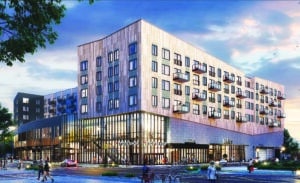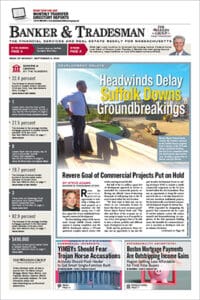
Developers have begun preleasing 165 apartments in the first phase of the Allston Yards project, which is approved for 868 multifamily housing units at a grocery-anchored shopping center on Everett Street. Image courtesy of Stantec
The viability of widescale office-to-residential conversion projects still is up for debate, but signs point to a greater awakening to incorporate multifamily housing into underutilized retail centers across Greater Boston.
From Burlington to Charlestown and over to Allston, developers and communities are studying how multifamily developments can complement existing retail properties. Leasing is underway at the Alder, a 165-unit apartment building at Allston Yards – a nearly 11-acre mixed-use project at a Stop & Shop-anchored shopping center near the Boston Landing MBTA commuter rail station. In Burlington, officials hope to attract more housing around the Burlington Mall by rezoning a 100-acre area dubbed the “Mixed Use Innovation District” around Mall Road.
A Boston Planning & Development Agency initiative is likely to encourage the trend in more city neighborhoods at a time when housing is desperately needed. The Squares+Streets initiative proposes zoning amendments that would allow higher-density housing in neighborhood centers around main streets in a variety of neighborhoods, with Roslindale Square and Cleary Square first on the list for rezonings.
Developers already have proposed 240 housing units at the Bunker Hill Mall in Charlestown, a project which is still under BPDA review, and 229 apartments and condominiums at the Whole Foods Market property at 15 Washington St. in Brighton, which was approved in December.
Respective spokespeople at Kimco Realty Corp., the developer behind the Brighton proposal, and New England Development, the developer behind the Charleston proposal, both declined to comment on the status of the projects.
“It’s a basic matter of having owners and/or developers that are trying to maximize the value of the land,” said Jeffrey Myers, a research director for Colliers. “Oftentimes, what we see when we think of shopping centers is there’s a lot of underutilized large parcels that are associated with those.”
Alder Grows Next to Allston Plaza
Allston Yards, where New England Development and Bozzuto are partnering, is a prime example of how developers are pursuing these projects. The Alder sits above a new Stop & Shop grocery store, which replaced the grocer’s original location at 60 Everett St. in Allston. Eventually, the plan is to fill up the broader mixed-use development with office and lab space, retail, more housing and public greenspace.
Developer Bozzuto had prior experience working in this space by redeveloping a similar Stop & Shop-anchored shopping center in Washington, D.C., into a multifamily project called Cathedral Commons near the National Cathedral.
“As you drive around, you see underutilized retail locations all over the place that have massive surface parking lots, or doors that have gone dark, or just centers that are no longer competitive in the in the retail landscape,” said Mike Henehan, president of Bozzuto Development Co. and Bozzuto Homes. “There’s certainly a lot of opportunity, but there’s a lot of risk that comes with it. You have to find the right group to be able to navigate and even want to entertain the risk and kind of the capital resources that you have to put into getting one of these to happen.”
Additionally, not all retail centers are created equally, and the key to success can be finding the right ownership structure and partners. Potential obstacles include the need to untangle a thicket of ownership rights.
“Mall properties are seemingly ripe for redevelopment, but the properties are really complex,” Henehan added. “They’re hard to unwind with various ownership rights, so it’s hard to find locations that you can actively redevelop in the near-term. Most of them take a long time to reposition and imagine.”

Developer Kimco Realty received approval from Boston officials last year to replace a single-story Whole Foods grocery store with a new space for the store topped with 229 apartments and condominiums. Image courtesy of Elkus Manfredi Architects
Multifamily Added to Drive Value
But there are a confluence of factors driving retail repositioning that includes a multifamily component. Some municipalities might want to address the housing shortage, but multifamily housing proposals can face pushback in less-dense neighborhoods.
Retail center owners and developers are likely wooed by the idea a multifamily component will drive more value to a property than retail tenants today. These retail centers are typically found in denser, commercial districts anyway.
“You’re going to find some municipalities – not all, but some – are just going to be more favorable for multifamily development in that type of situation and location than in alternative places where it might mean more competition or disruption to more low density or single-family neighborhoods,” Myers said.
Boston’s Squares+Streets initiative could unlock more opportunities for partnerships between retail and housing developers.
Additional neighborhoods like Allston Village, Cleveland Circle, Grove Hall and Upham’s Corner have also been selected for inclusion in future Squares+Streets rezoning, but don’t expect the changes to happen overnight. Incremental changes will emerge neighborhood by neighborhood after community input, a top BPDA official said.
“Zoning overhaul is a very complex process. Obviously, it involves analysis, data and best practices,” said Aimee Chambers, the director of planning at the BPDA. “But it also involves bringing people along, and that by itself is something that takes a lot of time and attention.”





